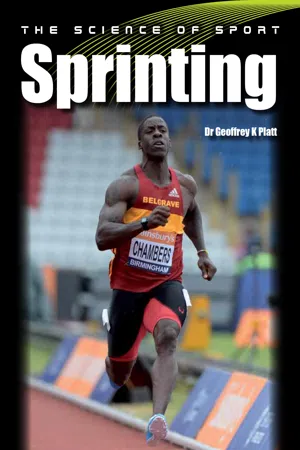
- 192 pages
- English
- ePUB (mobile friendly)
- Available on iOS & Android
Science of Sport: Sprinting
About this book
The Science of Sport: Sprinting examines the scientific principles that underpin the preparation and performance of athletics at all levels, from grassroots to Olympic competition. Drawing on the expertise of some of the world's leading coaches and sport science professionals, the book presents a detailed analysis of the latest evidence and explores the ways in which science has influenced, and subsequently improved, the sport of sprinting. By providing an overview of the principles of sport science and how these are applied in practice, the book is essential reading for students and academics, coaches and performers, physiotherapists, club doctors and professional support staff working in the sport. Key topics covered include: talent identification and youth development; biomechanics; performance analysis; coaching and coach education; training methods; fitness testing; nutrition; mental skills; incidence and treatment of injuries; performance lifestyle. Fully illustrated with 150 colour images and diagrams.
Frequently asked questions
- Essential is ideal for learners and professionals who enjoy exploring a wide range of subjects. Access the Essential Library with 800,000+ trusted titles and best-sellers across business, personal growth, and the humanities. Includes unlimited reading time and Standard Read Aloud voice.
- Complete: Perfect for advanced learners and researchers needing full, unrestricted access. Unlock 1.4M+ books across hundreds of subjects, including academic and specialized titles. The Complete Plan also includes advanced features like Premium Read Aloud and Research Assistant.
Please note we cannot support devices running on iOS 13 and Android 7 or earlier. Learn more about using the app.
Information
CHAPTER 1
AN INTRODUCTION TO THE SCIENCE OF SPRINTING
by Dr Geoffrey K. Platt
THE BACKGROUND TO SPORTS SCIENCE
Definition of Terms
Men
ATHLETICS – WORLD RECORDS




Table of contents
- Cover
- Title Page
- Copyright
- Contents
- Authors and Contributors
- 1 An Introduction to the Science of Sprinting by Dr Geoffrey K. Platt
- 2 Talent Identification and Development in Sprinting by Dr Mohsen Shafizadeh
- 3 Biomechanical Analysis of the Techniques of the Sprint Start by Professor Morteza Shahbazi Moghaddam
- 4 Biomechanics of Sprinting by Professor Morteza Shahbazi Moghaddam
- 5 Biomechanics of Sundry Sprint Skills by Professor Morteza Shahbazi Moghaddam
- 6 Performance Analysis in Sprinting by Dr Mohsen Shafizadeh
- 7 Coaching Sprinting by Interview with Tom McNab
- 8 Training Methods 1960–2014 by Dr Geoffrey K. Platt
- 9 Modern Training Methods by Dr Geoffrey K. Platt
- 10 Fitness Testing for Sprinting by Dr Geoffrey K. Platt
- 11 Nutrition for Sprinting by Dr Justin Roberts
- 12 Drugs in Sprinting by Wilf Paish, Tom McNab and Dr Geoffrey K. Platt
- 13 Mental Skills Training in Sprinting by Dr Andrew Cruickshank, Susan Giblin and Professor Dave Collins
- 14 Incidence and Treatment of Injuries in Sprinting by Dr Gino di Matteo
- 15 Performance Lifestyle for Sprinting by Dr Geoffrey K. Platt
- 16 References
- Index